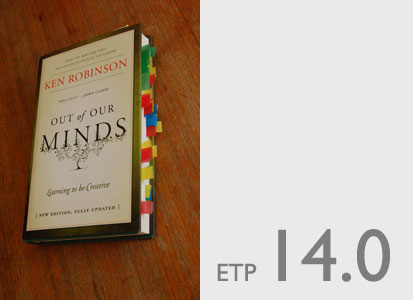It was slower going through this book (Out of Our Minds, 2011 edition, by Ken Robinson) compared to the time I read The Element. It might have been that there was less for me to “grab on to” or “reach out for” in terms of relatable situations, or perhaps there wasn’t much I was making notes of that would pertain to the youth program. In this entry (at least in the initial draft), I note some notable parts:
– “Creative schools are creative with the schedule”, p. 260. This reminds me of the curriculum at Bowman International School in Palo Alto where there is no strict subject schedule – except for a regular language class where it is essential for students to be feeling immersed in the language and speaking to each other and the teacher in that language. But even so, there is a thought-provoking argument as to whether having schools’ daily schedules suit the traffic schedule, the parents’ work schedule or the teachers’ workload schedule (as opposed to an optimum schedule for student learning) – are detrimental to the desired outcome of learning in depth and to a command level. What do the students in the YCISL workshops think?
– “Digital natives and digital immigrants”, p. 75 and 253. These terms are attributed to Mark Presnky, and are used to denote a phenomenon that moves in the opposite direction of [traditional] cultural transmission. With new technologies and platforms flying out of the idea factories, youth are far quicker to adopt, adapt and embrace these new ways of life, and often end up teaching the older generation (the digital immigrants – those moving out from the non-digital world). In normal cultural transmission, the older generation is typically engaged in trying to pass down traditions and processes that they grew up with in order to preserve them. So, for those youth who feel that they have something to teach adults, how would they do it?
– “The task of a creative leader is to facilitate a resilient relationship between the internal and external cultures”, p. 224. We could think of this in terms of a cell which has several internal components that are somewhat protected as a group by a semipermeable (selective) membrane but nonetheless must interact with the external environment to survive as well as thrive. This makes me think about the layers of a web site where there is an external interface but several layers of hidden internal function, form, design and architecture. The creative leader has to deal with all these layers.
– ” A culture of innovation depends on cultivating three processes”, p. 219. These processes are imagination, creativity and innovation. I don’t exactly agree with how this concept has been structured (including the exact definitions of the three processes in the book). If we are to follow the argument in The Element, imagination and creativity, don’t necessarily need to be “cultivated”, they need to be uncovered – by social or organizational pressures. On the other hand, I think it is fair to say that “innovation” is cultivated. However, I would further the book’s definition of “innovation” to say that this process is a selective one. With regards to the definition of “creativity”, I would not exclude ideas because they are not “original” – the same creative idea could come about by different routes – and it all requires energy and expression. I guess you could think of this as a multi-path chemical reaction with similar reactants but the exact same product (albeit perhaps with different yields, energy of reaction and activation energies).
– “The intellect cannot work at its best without emotional intelligence”, p. 186. Perhaps something Stephen Murphy-Shigemtasu can address? More on Emotional Intelligence on p. 175.
– “Academic ability is based on the two capacities for logico-deductive reasoning and for propositional knowledge”, p. 83.


